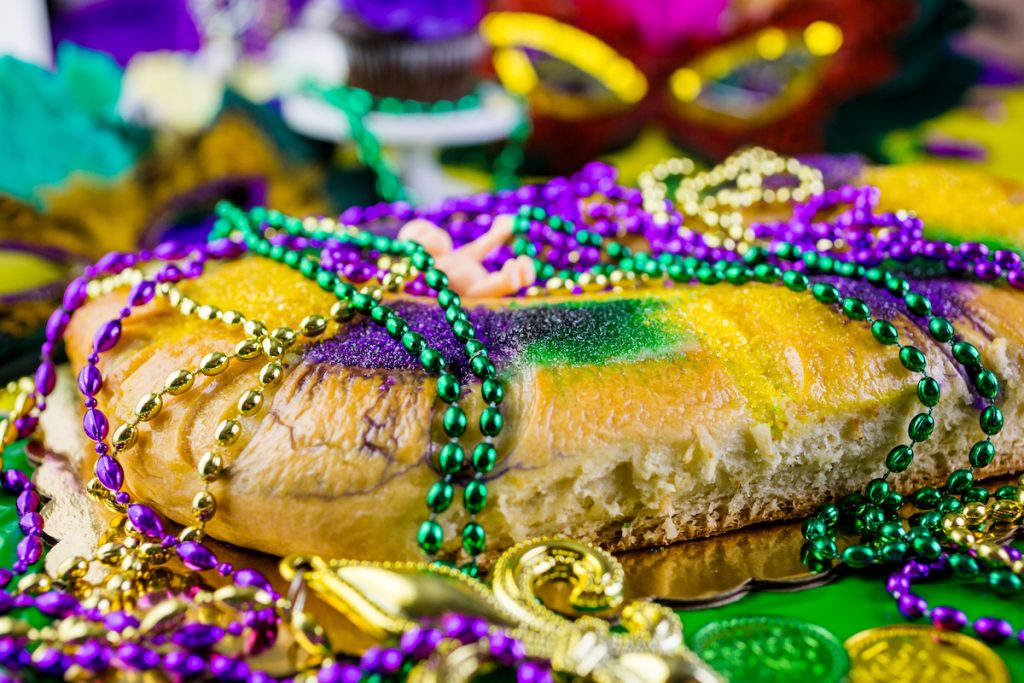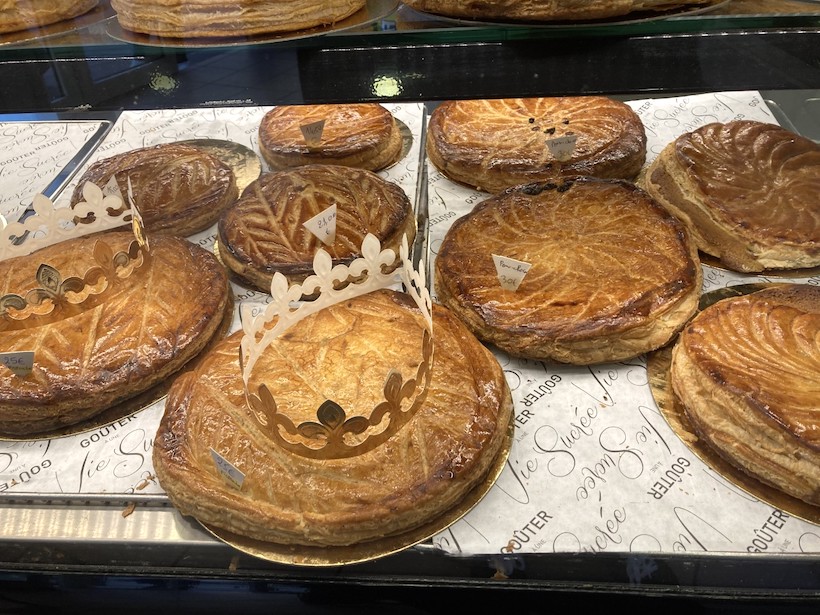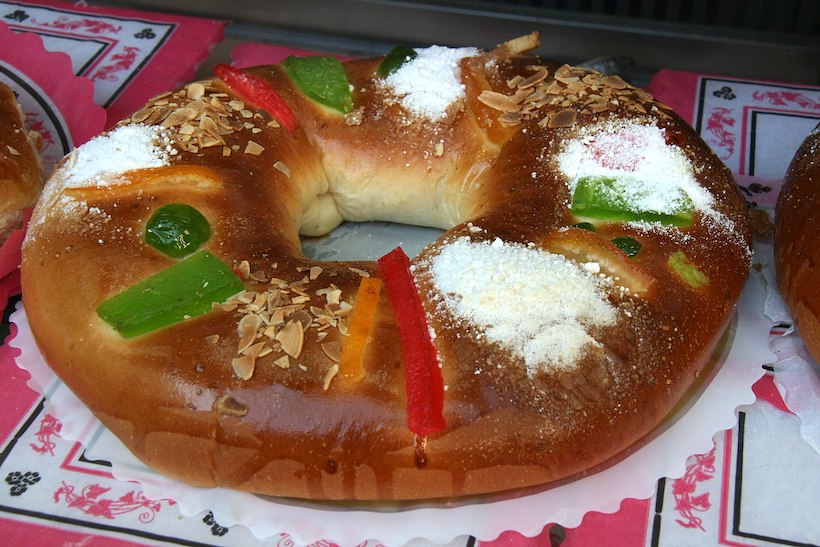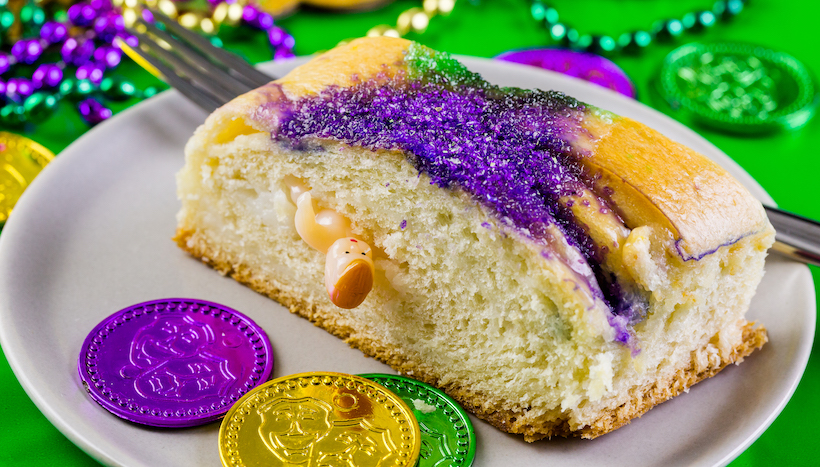The twelfth day of Christmas, also known as the Epiphany, is the day the Three Wise Men – the Magi – first met the baby Jesus. The day also celebrates the start of Mardi Gras or the Carnival season. One of the ways we celebrate the season? We eat king cakes.
This tradition traveled through Spain to France and eventually spread to the U.S. – especially in and around the Gulf Coast region. Traditionally, pecans, beans, or coins were placed inside the cakes before baking to symbolize the baby Jesus.
And that's just a taste – as you can imagine, the history of the king cake is as rich and complex as the cake itself.

The king cake is a cake – sometimes more akin to coffee cake or sweet bread – associated with the Christian Epiphany. Depending on the local tradition, you eat king cake on Twelfth Night – January 6th, 12 days after the birth of Jesus or perhaps all throughout Carnival preceding the liturgical season of Lent.
The word Epiphany stems from the Greek word meaning "to show or reveal," and describes the day when the Magi or the Three Wise Men reached Bethlehem, and Jesus was revealed to them and to the world at large as King. Naturally, (as with most holidays in Christianity), this calls for a celebration. History indicates that the Feast of the Epiphany was celebrated as early as the second century, A.D.
The first cakes were oval-shaped and were probably dense and a little bland – more like bread than cake – since sugar and yeast were not easily available a few hundred years ago.
Gradually, as the celebrations became more elaborate, the cake itself transformed, too. Bakers started adding honey for sweetness and moistness, and the discovery of yeast meant that baked goods were lighter and less dense. Over the years, the shape also changed from a rough oval shape to anywhere from an elaborately decorated crown to a delicate braided pastry ring.
Regional differences also emerged late in the 18th century. In France, a king cake may be a delicate brioche in the shape of a circle, topped with glaze and roasted nuts or sugar. A Spanish king cake may also be baked in an oval, and is known as a roscón de reyes (ring of the kings). This cake is traditionally a little denser and decorated with dried fruits or nuts.
Whatever shape the king cake takes, one detail is constant: the symbol of a baby Jesus is placed in the cake before baking.
In the past, dried beans, coins, or nuts were baked inside a cake, but most present-day king cakes come with a little plastic baby Jesus. If you're so blessed as to find the token inside – congratulations! The plastic baby is good luck; the only catch is it's time to start planning – next year, you need to host the party.
In the U.S., the history of king cake is diverse, and ingredients, designs, and decorations vary from one bakery to the next, resembling anything from a plain coffee cake to an elaborately decorated French pastry. Current versions are a glazed pastry in the form of a ring, decorated with alternating bands of colored sugar in the Carnival colors of purple, green, and gold.

Although it's logical to assume the history of king cake is based on Christianity, it's possible it traces back to an even earlier pagan Roman festival: Saturnalia.
Saturnalia honored the god Saturn and was a celebration of sowing and the harvest. It was a lengthy holiday, December 17-23, marked by raucous parties and the temporary shelving of Roman norms – such as the restrictions on gambling.
Back then, fava beans were a valuable commodity and sometimes used as currency. During Saturnalia, festivities gradually the custom came about of putting a bean inside baked cakes. Then, as now, if you found the bean, you were destined for luck in the new year.
Saturnalia and Sol Invictus and the New Years' celebrations eventually blended together (as you saw in the history of the yule log). Sometime in the Middle Ages, they gave rise to the Epiphany.
Over time the fava bean in a dish was replaced with other things and trinkets, such as coins or fruit. But it was the French who solidified the tradition – the French Galette des Rois even survived a French famine in 1711 banning non-bread flour usage – and the anti-royalty French Revolution!
The French also gave us pour tirer les rois – "to find the king", or the bean representing the king, as the case may be. In the earlier days of the tradition, when a slave would find the 'king,' it would invert the power, and they would be treated as "king for a day."
The French also deserve credit for spreading the tradition to the United States. Likely sometime in the late 1800s, the king cake was brought to Louisiana by French settlers who associated the food with Mardi Gras.
Naturally, they brought their homeland traditions and recipes with them, but the earlier versions of king cake were more of a flaky puff pastry filled with almond cream and decorated with nuts or fruit. That's right – even though history points to French-influence in introducing the cake, the Spanish king cake seems to have a better foothold.
In the United States, the king cake has long since moved on from fava beans and coins. The current U.S. version of a baby came about by happy accident.
One day in 1940s Louisiana, Donald Entringer, a Louisiana baker, found tiny porcelain dolls – and with the blessing of the local health department, started baking them into his king cakes. The recipe was an instant success, and over time the porcelain dolls were replaced with plastic dolls.
That leads to one of the stranger pieces of king cake history in the United States – in one of the most over-lawyered countries in the world, it's nigh-impossible to find a cake with a pre-baked plastic baby inside. While, yes, you shouldn't bake plastic, it's more common now for a baby to be provided separately – for you to place under the cake, instead of hidden inside.
And just like with toys in the infamous Kinder Egg, the U.S. Food and Drug Administration forbids the plastic baby decoration since it's a nonedible item inside food.
Willing to buy your own? Nowadays, these dolls can be found in all colors and designs, and some bakeries even include a limited edition, collectible doll.

As mentioned, bakeries in France and Belgium serve the galette de rois, a version that's truer to the original form of puff pastry filled with almond cream. Germany and Switzerland serve Dreikönigskuchen, a sweet bun topped with almonds and raisins, while the English enjoy simple frosted fruitcakes.
Most European countries don't include the plastic doll in the king cake; rather, they use nuts or candied fruit to symbolize the Christ child.
Along with food comes celebration.
Here's a fun fact – the first Mardi Gras parade was actually celebrated in Mobile, AL. Over time, the New Orleans celebration became more decadent, over the top, and wildly extravagant – and took over the public's association with the holiday (Mobile still has an amazing celebration though, check it out).
Gradually the celebration included parades and floats. Organizations that organize elements of the celebration are known as krewes. In 1856, six businessmen got together and formed the Mistick Krewe of Comus, the first official krewe (and longest contiguous krewe) of Mardi Gras.
Today, the Mardi Gras season is a nearly two-month celebration that begins with Epiphany—twelve days after Christmas—and ends on Fat Tuesday, the day before Ash Wednesday –the start of the Lenten season.

Here are some fun facts about the king cake:

Even though king cake doesn't enjoy the universal spread of other holiday-associated foods, it's a trusty stalwart of the Gulf Coast's Mardi gras celebrations. Reminding Christians and partiers the "reason for the season", the king cake is a decadent lead-in to the liturgical Lenten season – a season Christians practice moderation and fasting.
So if you get a chance to celebrate with some king cake, enjoy the occasion – and if you find the plastic baby, throw an incredible party. Oh –– am I invited?
Cher Gerard,
Merci de votre mail. Cette annee nous avons mange une galette le 6 janvier pour feter l\'anniversaire de ma femme. C\'est elle d\'ailleurs qui a trouve le bebe Jesus! La petite poupee etait dans le gateau que nous avons acheter a la boulangerie Le Panier qui se trouve au Pike Place Market a Seattle.